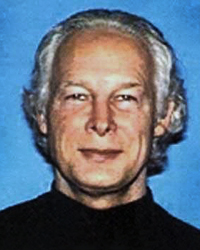
Photographer Unknown

Photographer Unknown, 1997
Erowid Character Vaults
William Leonard Pickard
October 21, 1945 -
Jul 24 2020: Judge Orders William Leonard Pickard Released
Due to COVID-19 pandemic-related concerns that older inmates in US federal prison are at "risk [of] substantial injury", and that 20 years in prison "is sufficient to serve the goals of incapacitation, deterrence, retribution, and rehabilitation. The § 3553(a) factors support reducing defendant's sentence to time served, to be followed by a five-year term of supervised release." See p. 11 of the order for release.
Summary
William Leonard Pickard studied neurobiology at U.C. Berkeley, and later graduated from the Kennedy School of Government at Harvard with degrees in chemistry and public policy. For a couple of years he worked as the deputy director of UCLA's Drug Policy Analysis Program. Within the psychedelic community, Pickard's notoriety stems from his arrests related to illicit drug manufacturing, concluding with the infamous "Kansas missile silo" bust in November of 2000, when he was arrested on charges of conspiracy to distribute LSD and possession with the intent to distribute and dispense LSD. After being found guilty at trial, his partner Clyde Apperson received a thirty-year prison sentence, while Pickard got two life sentences. The arrest came about due to their associate Gordon Todd Skinner, a DEA informant. (In matters not directly related to the missile silo case, Skinner was, himself, later arrested and convicted of assault, kidnapping, and conspiracy charges, receiving a "life plus 90 years" prison sentence.)
In a March 31, 2003 DEA press release it was claimed that the Pickard/Apperson bust represents "the largest LSD lab seizure ever made by the Drug Enforcement Administration", with "approximately 41.3 kilograms" of LSD having been seized. These ideas regarding the magnitude of the lab's LSD production have been widely reported and often repeated, yet they appear to be vast exaggerations. Although a DEA forensic chemist's testimony later revealed that the "actual amount of all the exhibits containing LSD was 198.9 grams of LSD", it has been pointed out by one reporter that even that figure was an extrapolated estimate rather than a known quantity. And despite the November 20, 2003 testimony from the aforementioned DEA chemist, the "approximately 41.3 kilograms" figure remains posted on the DEA's website. Within a paper delivered in absentia at the World Psychedelic Forum in March of 2008, Pickard's own thoughts regarding "International LSD Prevalence - Factors Affecting Proliferation and Control" were voiced.
From behind bars, Pickard continued to fight for his freedom and to draw attention to the ways in which the DEA maintains records on U.S. citizens. In 2011 he published an article about the Narcotics and Dangerous Drugs Information System titled "DEA's NADDIS System: A Guide for Attorneys, the Courts, and Researchers". In July 2020, his term of imprisonment was reduced to time served.
In a March 31, 2003 DEA press release it was claimed that the Pickard/Apperson bust represents "the largest LSD lab seizure ever made by the Drug Enforcement Administration", with "approximately 41.3 kilograms" of LSD having been seized. These ideas regarding the magnitude of the lab's LSD production have been widely reported and often repeated, yet they appear to be vast exaggerations. Although a DEA forensic chemist's testimony later revealed that the "actual amount of all the exhibits containing LSD was 198.9 grams of LSD", it has been pointed out by one reporter that even that figure was an extrapolated estimate rather than a known quantity. And despite the November 20, 2003 testimony from the aforementioned DEA chemist, the "approximately 41.3 kilograms" figure remains posted on the DEA's website. Within a paper delivered in absentia at the World Psychedelic Forum in March of 2008, Pickard's own thoughts regarding "International LSD Prevalence - Factors Affecting Proliferation and Control" were voiced.
From behind bars, Pickard continued to fight for his freedom and to draw attention to the ways in which the DEA maintains records on U.S. citizens. In 2011 he published an article about the Narcotics and Dangerous Drugs Information System titled "DEA's NADDIS System: A Guide for Attorneys, the Courts, and Researchers". In July 2020, his term of imprisonment was reduced to time served.
Links
Links


